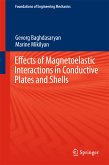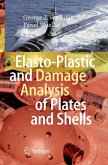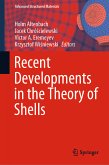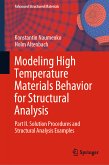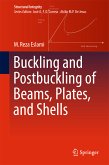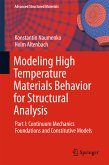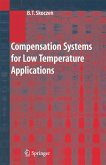Material Modeling and Structural Mechanics (eBook, PDF)
Redaktion: Altenbach, Holm; Wallmersperger, Thomas; Naumenko, Konstantin; Kästner, Markus; Beitelschmidt, Michael
-54%11
97,95 €
213,99 €**
97,95 €
inkl. MwSt.
**Preis der gedruckten Ausgabe (Gebundenes Buch)
Sofort per Download lieferbar

49 °P sammeln
-54%11
97,95 €
213,99 €**
97,95 €
inkl. MwSt.
**Preis der gedruckten Ausgabe (Gebundenes Buch)
Sofort per Download lieferbar
Alle Infos zum eBook verschenken

49 °P sammeln
Als Download kaufen

213,99 €****
-54%11
97,95 €
inkl. MwSt.
**Preis der gedruckten Ausgabe (Gebundenes Buch)
Sofort per Download lieferbar

49 °P sammeln
Jetzt verschenken
Alle Infos zum eBook verschenken
213,99 €****
-54%11
97,95 €
inkl. MwSt.
**Preis der gedruckten Ausgabe (Gebundenes Buch)
Sofort per Download lieferbar
Alle Infos zum eBook verschenken

49 °P sammeln
Material Modeling and Structural Mechanics (eBook, PDF)
Redaktion: Altenbach, Holm; Wallmersperger, Thomas; Naumenko, Konstantin; Kästner, Markus; Beitelschmidt, Michael
- Format: PDF
- Merkliste
- Auf die Merkliste
- Bewerten Bewerten
- Teilen
- Produkt teilen
- Produkterinnerung
- Produkterinnerung

Bitte loggen Sie sich zunächst in Ihr Kundenkonto ein oder registrieren Sie sich bei
bücher.de, um das eBook-Abo tolino select nutzen zu können.
Hier können Sie sich einloggen
Hier können Sie sich einloggen
Sie sind bereits eingeloggt. Klicken Sie auf 2. tolino select Abo, um fortzufahren.

Bitte loggen Sie sich zunächst in Ihr Kundenkonto ein oder registrieren Sie sich bei bücher.de, um das eBook-Abo tolino select nutzen zu können.
This book presents various questions of continuum mechanical modeling in the context of experimental and numerical methods, in particular, multi-field problems that go beyond the standard models of continuum mechanics. In addition, it discusses dynamic problems and practical solutions in the field of numerical methods. It focuses on continuum mechanics, which is often overlooked in the traditional division of mechanics into statics, strength of materials and kinetics. The book is dedicated to Prof. Volker Ulbricht, who passed away on April 9, 2021.
- Geräte: PC
- ohne Kopierschutz
- eBook Hilfe
- Größe: 17.57MB
Andere Kunden interessierten sich auch für
![Effects of Magnetoelastic Interactions in Conductive Plates and Shells (eBook, PDF) Effects of Magnetoelastic Interactions in Conductive Plates and Shells (eBook, PDF)]() Gevorg BaghdasaryanEffects of Magnetoelastic Interactions in Conductive Plates and Shells (eBook, PDF)73,95 €
Gevorg BaghdasaryanEffects of Magnetoelastic Interactions in Conductive Plates and Shells (eBook, PDF)73,95 €![Elasto-Plastic and Damage Analysis of Plates and Shells (eBook, PDF) Elasto-Plastic and Damage Analysis of Plates and Shells (eBook, PDF)]() George Z VoyiadjisElasto-Plastic and Damage Analysis of Plates and Shells (eBook, PDF)113,95 €
George Z VoyiadjisElasto-Plastic and Damage Analysis of Plates and Shells (eBook, PDF)113,95 €![Recent Developments in the Theory of Shells (eBook, PDF) Recent Developments in the Theory of Shells (eBook, PDF)]() Recent Developments in the Theory of Shells (eBook, PDF)113,95 €
Recent Developments in the Theory of Shells (eBook, PDF)113,95 €![Modeling High Temperature Materials Behavior for Structural Analysis (eBook, PDF) Modeling High Temperature Materials Behavior for Structural Analysis (eBook, PDF)]() Konstantin NaumenkoModeling High Temperature Materials Behavior for Structural Analysis (eBook, PDF)73,95 €
Konstantin NaumenkoModeling High Temperature Materials Behavior for Structural Analysis (eBook, PDF)73,95 €![Buckling and Postbuckling of Beams, Plates, and Shells (eBook, PDF) Buckling and Postbuckling of Beams, Plates, and Shells (eBook, PDF)]() M. Reza EslamiBuckling and Postbuckling of Beams, Plates, and Shells (eBook, PDF)193,95 €
M. Reza EslamiBuckling and Postbuckling of Beams, Plates, and Shells (eBook, PDF)193,95 €![Modeling High Temperature Materials Behavior for Structural Analysis (eBook, PDF) Modeling High Temperature Materials Behavior for Structural Analysis (eBook, PDF)]() Konstantin NaumenkoModeling High Temperature Materials Behavior for Structural Analysis (eBook, PDF)73,95 €
Konstantin NaumenkoModeling High Temperature Materials Behavior for Structural Analysis (eBook, PDF)73,95 €![Compensation Systems for Low Temperature Applications (eBook, PDF) Compensation Systems for Low Temperature Applications (eBook, PDF)]() Balzej T. SkoczenCompensation Systems for Low Temperature Applications (eBook, PDF)113,95 €
Balzej T. SkoczenCompensation Systems for Low Temperature Applications (eBook, PDF)113,95 €-
-
-
This book presents various questions of continuum mechanical modeling in the context of experimental and numerical methods, in particular, multi-field problems that go beyond the standard models of continuum mechanics. In addition, it discusses dynamic problems and practical solutions in the field of numerical methods. It focuses on continuum mechanics, which is often overlooked in the traditional division of mechanics into statics, strength of materials and kinetics. The book is dedicated to Prof. Volker Ulbricht, who passed away on April 9, 2021.
Dieser Download kann aus rechtlichen Gründen nur mit Rechnungsadresse in A, B, BG, CY, CZ, D, DK, EW, E, FIN, F, GR, HR, H, IRL, I, LT, L, LR, M, NL, PL, P, R, S, SLO, SK ausgeliefert werden.
Produktdetails
- Produktdetails
- Verlag: Springer International Publishing
- Seitenzahl: 336
- Erscheinungstermin: 30. März 2022
- Englisch
- ISBN-13: 9783030976750
- Artikelnr.: 63674915
- Verlag: Springer International Publishing
- Seitenzahl: 336
- Erscheinungstermin: 30. März 2022
- Englisch
- ISBN-13: 9783030976750
- Artikelnr.: 63674915
- Herstellerkennzeichnung Die Herstellerinformationen sind derzeit nicht verfügbar.
Prof. Dr.-Ing. habil. Dr. h.c. mult Holm Altenbach has held positions at the Otto-von-Guericke-Universität Magdeburg and at Martin-Luther-Universität Halle-Wittenberg, Germany. He graduated from Leningrad Polytechnic Institute in 1980 (with a diploma on the Dynamics and Strength of Machines), where he defended his Ph.D. in 1983 and was awarded the title Doctor of Technical Sciences in 1987. Currently, he is Full Professor of Engineering Mechanics at the Otto von Guericke University, Faculty of Mechanical Engineering, Institute of Mechanics (since 2011), and has been Acting Director of the Institute of Mechanics since 2015. His areas of scientific interest are general theory of elastic and inelastic plates and shells, creep and damage mechanics, strength theories, and nano- and micromechanics. He has been honored with various awards, including the 1992 Krupp Award (Alexander von Humboldt Foundation); 2000 Best Paper of The Year from the Journal of StrainAnalysis for Engineering Design; 2003 Gold Medal from the Faculty of Mechanical Engineering, Politechnika Lubelska, Lublin, Poland; 2004 Semko Medal from the National Technical University of Kharkov, Ukraine; 2007 Doctor honoris causa from the National Technical University Kharkov, Ukraine; 2011 Fellow of the Japanese Society for the Promotion of Science; 2014 Doctor honoris causa from the Ovidius University of Constanta, Romania; 2016 Doctor honoris causa from the Vekua Institute, Tbilisi, Georgia; and the 2018 Alexander von Humboldt Award (Poland). Since 2019 he is a foreign member of the Russian Academy of Sciences and since 2021 - of the National Academy of Sciences of Ukraine. Michael Beitelschmidt is since 2010 full professor for Dynamics and Mechanism Design at the Institute of Solid Mechanics at TU Dresden, Germany. From 2005 to 2010 he held the position of a full professor for Vehicle Modeling and Simulationat the Faculty of Transport and Traffic Sciences at TU Dresden. Since 2019 he is the Director of the Institute of Solid Mechanics and since 2008 the Dean of Studies for Mechatronics. His research topics comprise the simulation of dynamics, vibration and acoustics applied to several industrial fields e.g. railway vehicles or textile machines. Other applications are thermoelectrics and thermomechanics. Since a few years robotics and drone technology are emerging research fields. In 2016 he spent 6 months as visiting professor at the University of Illinois at Chicago with Prof. Ahmed Shabana. From 1998 to 2005 Michael Beitelschmidt worked at Sulzer Innotec (R&D division) in Wintherthur (Switzerland) as engineer, the last position was the head of the mechanics department. He completed his dissertation (Ph.D. thesis) in 1998 in impacts in multi-body systems at TU München under the supervision of Prof. Friedrich Pfeiffer. He is a reviewer for multiple scientific journals and research funding organizations. Since 2019 he is review board member of the DFG (German Research Foundation). Since 1998, Michael Beitelschmidt has published more than 120 conference and journal articles. He is co-author of two textbooks. Professor Markus Kästner obtained his postdoctoral lecture qualification (Habilitation) for Solid Mechanics, Technische Universität Dresden, during 2015/12. In 2009/12, Prof. Markus Kästner did his graduation with doctoral degree Dr.-Ing. (with distinction) at Technische Universität Dresden, under Prof. V. Ulbricht being Supervisor. In 2016/10, Prof. Markus Kästner is a present Full Professor for Computational and Experimental Solid Mechanics and Acting Head of durability working group, Institute of Solid Mechanics, Technische Universität Dresden. During 2014/05-10, Prof. Markus Kästner did research visit in the University of Glasgow with the host Prof. René de Borst. Prof. Markus Kästneris's Postdoctoral Scholarship (DAAD) includes the following: Head of working group Multiscale Modeling and Simulation Institute of Solid Mechanics, Technische Universität Dresden, in 2012/01-2016/09; Research Associate, Institute of Solid Mechanics, Technische Universität Dresden, in 2004/12-2011/12; in 2021, Editor of Special Issue on additive manufacturing, GAMM-Mitteilungen; in 2021, Editor of Special Issue on exploiting process-induced residual stresses, Archive of Applied Mechanics; in 2019, present Member of editorial board Archive of Applied Mechanics; in 2019, present Member of the German Association for Computational Mechanics (GACM); in 2017, present Member of the International Association of Applied Mathematics and Mechanics (GAMM); and in 2014, present Member Dresden Center for Computational Materials Science (DCMS). During 2012/1-2015/12 PI CRC 639, Prof. Markus Kästneris was Ongoing Reviewer for DAAD, DFG, AvH Foundation, HRZZ, and STIFT for several scientific journals including Nature, Computational Mechanics, Computer Methods in Applied Mechanics and Engineering, International Journal for Numerical Methods in Engineering, Journal of Computational Physics, and Mechanics of Materials. Prof. Konstantin Naumenko is Professor at the Institute of Mechanics, Otto von Guericke Universität Magdeburg. Konstantin does research in structural mechanics, materials modeling, and mechanical engineering. Thomas Wallmersperger is a Full Professor for Mechanics of Multifunctional Structures at the Institute of Solid Mechanics at TU Dresden, Germany (since 2011), and Associate Dean of the Faculty of Mechanical Science and Engineering at TU Dresden since 2016. From 2016 until 2019 he served as Director of the Institute of Solid Mechanics. His research topics comprise coupled multi-field problems, adaptive materials and smart structures, modeling and simulation of soft and hard materials, discretization and numerical methods. Thomas Wallmersperger completed his dissertation (Ph.D. thesis) in 2003 and his habilitation in 2010 at University of Stuttgart, Germany. In the years 2005 and 2006 he conducted research stays as Visiting Professor at the Center for Intelligent Material Systems and Structures at Virginia Polytechnic Institute and State University, VA, US, in the field of Electroactive Ionic Polymers with the Professors Donald J. Leo and Daniel J. Inman. He has been a reviewer for multiple scientific journals and organizer of the Second International Symposium on Design, Modeling and Experiments of Adaptive Structures and Smart Systems (DeMEASS II) and of DeMEASS VII. Professor Wallmersperger is Associate Editor of the Journal of Intelligent Material Systems and Structures, Editorial Advisory Board Member of Acta Mechanica, Advisory Committee Member of the International Symposium on Design, Modelling and Experiments of Adaptive Structures and Smart Systems, and Program Committee Member for theSPIE-Conference Electroactive Polymer Actuators and Devices (EAPAD). Since 2000, Thomas Wallmersperger has published more than 150 conference and journal articles.
1. The Use of the Homogenization Method in the Analysis of Anisotropic Creep in Metal-matrix Composites.- 2. General Forms of Limit Surface: Application for Isotropic Materials.- 3. Model Order Reduction: The Bridge Between Structural Mechanics and System Simulation.- 4. Identification of Temperature Dependent Material Properties in Composite Plates Utilizing Experimental Vibration Data. 5. Unilateral Constraints and Multibody Dynamics.
1. The Use of the Homogenization Method in the Analysis of Anisotropic Creep in Metal-matrix Composites.- 2. General Forms of Limit Surface: Application for Isotropic Materials.- 3. Model Order Reduction: The Bridge Between Structural Mechanics and System Simulation.- 4. Identification of Temperature Dependent Material Properties in Composite Plates Utilizing Experimental Vibration Data. 5. Unilateral Constraints and Multibody Dynamics.

